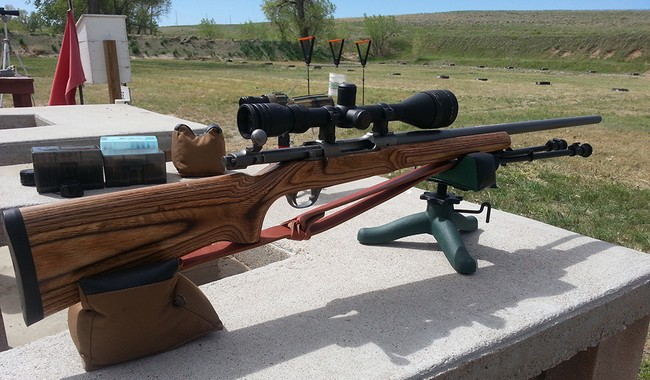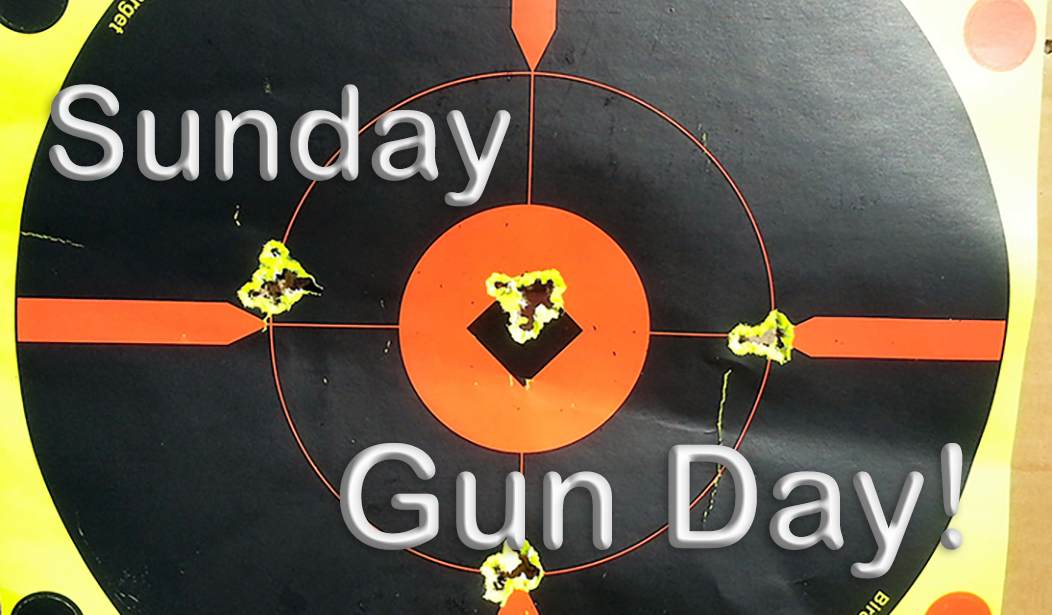Today in Bolt Guns
Let’s take a highly condensed look at the state of the bolt gun market as it stands today.
Previously on RedState: Sunday Gun Day XXIX - The History of Bolt Guns, Part I
Sunday Gun Day XXX - the History of Bolt Guns, Part II
Sunday Gun Day XXXI - The History of Bolt Guns, Part III
Sunday Gun Day XXXII - The History of Bolt Guns, Part IV
Sunday Gun Day XXXIII - The History of Bolt Guns, Part V
Remington
Winchester got the first billing last time, so this time we’ll give it to Remington.
The Remington Model 700 is still going strong, offered in a variety of configurations from wood-stock sporters to full-up Tacticool. The great old BDL is still for sale, along with the lower-priced, blind magazine ADL. Remington is still offering the carriage trade, $2,400 Model 700 200th Anniversary Limited Edition Model 700, of which rifles only 2,016 have been made. Remington even offers a muzzle-loader on the Model 700 action, in which the bolt opens to allow a 209 shotgun primer to be placed into the breech for ignition.
Remington once offered the light and handy little Model 7, a short-action, light-barreled carbine in several varieties with wood, laminate, and synthetic stocks. I considered one of these rifles for my wife and handled several, although I didn’t take the chance to shoot one. It’s a neat little rifle and would be great for close-quarters work, as it handles quickly and points very naturally; I'm a little baffled as to why Remington has apparently discontinued it.
The Model 783 is something new. This rifle started out life as the Marlin X-7 rifle and was absorbed into Big Green when Remington acquired the old lever gun manufacturer. The 783 continues that weapon’s floating bolt head, detachable box magazine, and small ejection port, which makes for a very strong receiver. The 783 more or less fills the role once held by the old Model 788.
Winchester
This great old company now offers two bolt rifles. The first is of course the Rifleman’s Rifle, the Model 70, now only offered with a blade ejector and controlled-feed claw extractor. An improved trigger was recently added. You can get this fine old rifle in Super Grade with a French walnut, American black walnut, or fine blonde maple stocks. Stainless versions are offered, with wood or synthetic stocks.
If you’re on a budget, Winchester has the XPR, a push-feed, synthetic-stocked, no-frills hunting rifle. The XPR, like the Remington 783, departs from the traditional Model 70 with its 3-lug bolt, detachable magazine, and slide safety.
One thing I find interesting about Winchester is that they have eschewed the Tacticool craze in their bolt guns. While Remington offers several Tacticool varieties of the Model 700, Winchester’s rifles are sporting rifles, pure and simple; there are models with synthetic stocks but the new Winchester seems to be eschewing the ugly “tactical” stocks and the practice of hanging a Picatinny rail on every available surface. Mind you, I’m not saying that’s good or bad, but it’s interesting, speaks somewhat to the new Winchester’s marketing strategy, and honestly, makes me like that company just a little bit more.
It’s probably a bit odd that I don’t have a Model 70 in the rack. If I could find a Safari-grade, pre-64 Model 70 in .375 H&H, I might just be tempted to buy it – if I could get it for a price that wouldn’t put me in my wife’s sights.
There are, of course, lots of other bolt guns on the market.
The Other Guys
It should come as a surprise to no one that I’m a fan of Browning products. While the modern-day Browning and the modern-day Winchester share their corporate owners, their bolt gun offerings are quite different.
The Browning A-bolt has been discontinued, but the general pattern of the action lives on in the AB3 and, to some extent, the X-bolt, both of which share the earlier rifle’s three locking lugs and 60-degree bolt throw. Both rifles feature detachable magazines, but while the AB3 uses the traditional style box magazine, the X-bolt uses a new design, a rotary magazine roughly like that of the Savage 99.
While both rifles have good reputations, I haven’t fired or handled either, so can’t offer any personal recommendation. Ruger bolt guns, on the other hand, I am more familiar with, and I have to say my experiences have been positive.
Of all the American manufacturers, Ruger probably has the largest lineup of bolt guns. Ruger’s supply covers a very wide range, so I’ll mention a couple I find particularly interesting.
The latest version of the basic Model 77 platform is the Hawkeye Standard Rifle. Like the original M77, it uses an updated, modernized version of the 98 Mauser action, but unlike the original M77, it uses a Winchester-style three-position four-and-aft safety. It comes in a good variety of calibers and finishes. Ruger sells cheaper rifles with the same basic action, but the American has a cleaner finish and is available with some good wood furniture.
 An interesting variant on the M77 is the Scout Rifle, made to the concept first floated by the late Colonel Jeff Cooper. This bolt gun has an 18” barrel, muzzle brake, a Picatinny rail allowing for an intermediate eye relief scope, a ten-round detachable magazine, and either a laminated wood or synthetic stock. Unlike the late Colonel Cooper, I see little application for this rifle in a modern military, but it is, even so, a short, handy rifle; five-round mags are available to meet most state’s hunting rifle restrictions. The Scout was first put out in .308 Winchester and .243 Winchester but is available now in the thumping .450 Bushmaster, which would make an interesting brush gun. If they only made it in .358 Winchester, I would probably own one by now.
An interesting variant on the M77 is the Scout Rifle, made to the concept first floated by the late Colonel Jeff Cooper. This bolt gun has an 18” barrel, muzzle brake, a Picatinny rail allowing for an intermediate eye relief scope, a ten-round detachable magazine, and either a laminated wood or synthetic stock. Unlike the late Colonel Cooper, I see little application for this rifle in a modern military, but it is, even so, a short, handy rifle; five-round mags are available to meet most state’s hunting rifle restrictions. The Scout was first put out in .308 Winchester and .243 Winchester but is available now in the thumping .450 Bushmaster, which would make an interesting brush gun. If they only made it in .358 Winchester, I would probably own one by now.
Both rifles, along with most of Ruger’s stable, are available in left-handed versions for you southpaws.
Mossberg may be better known for their shotguns, but after some experimentation that old family-owned company offers a couple of good bolt guns. The Mossberg Patriot is a standard push-feed bolt gun offered in traditional wood furniture as well as synthetics. The bolt body is cut with spiral flutes for some reason; the Patriot also has a good, clean, externally adjustable trigger unique to Mossberg. Also available is the MVP, which mates the Patriot action to a synthetic stock and detachable, AR-pattern magazines. If you live in a jurisdiction that is hostile to AR-pattern rifles, you can at least get a bolt gun to use your stockpile of AR magazines.
And then we have Savage. Their entry into riflery may have been the Model 99 lever gun, but we have already discussed their 110 bolt gun. Savage these days seems to compete with Ruger for the biggest variety of bolt guns for sale; they still offer the 110 in a great variety of finishes and calibers but also the Axis bolt gun and the Savage 11 hunting and 12 target rifles. Like the original 110, Savage offerings tend to be robust, reliable, and affordable. Better, their more recent offerings are more attractive than the original, clunky 110, but only the 11 and 111 Hunter rifles feature wood stocks.
I’ve only scratched the surface of standard domestic bolt gun offerings, but I wanted to take a little space to describe some upscale offerings as well.
The Semi-Customs
Up in Kalispell, Montana, there is a company, rather aptly named the Montana Rifle Company, making high-end bolt guns based on what is essentially a 98 Mauser action with a Winchester 70-style fore and aft safety. Their basic model, the American Standard Rifle, starts at about $1,500; the price of the fancier models rises rapidly from there. I’ve toyed with the idea of buying their American Legends Rifle in my favored .338 Win Mag, and in so doing gaining a rifle that for all intents and purposes is a brand-new pre-64 Model 70 Winchester. One of these in .375 H&H would be good medicine for big bears and moose.
A step up the price and fanciness ladder will get you another Montana production from the Cooper Firearms Company. Their rifles carry a ½ MOA accuracy guarantee, can be had with lovely AA Claro walnut stocks, hand-cut checkering, and a detachable box magazine for quick reloads.
Kimber is a company known for some fancy 1911 clones, but they also produce some high-end bolt guns. The Kimber bolt action, like the Montana, is a well-made clone of the pre-64 Model 70. Kimber offers their Traditional and Dangerous Game versions with fine walnut furniture, along with the likes of the Hunter and Mountain series with synthetic stocks.
Meanwhile, in other parts of the world, more great bolt guns are being cranked out.
Around the World
Advertising themselves as Das Original, a company called Mauser is still in the bolt gun game, producing their Mauser 12 bolt gun. Interestingly, this latest Mauser lacks the classic big claw extractor of the classic Model 98, but the M12 is gathering a good reputation as a solid, smooth reliable rifle, especially in those European nations where the peasantry is still allowed to own firearms.
Best of all, though, is the fact that the new Mauser still – still, after almost 120 years – offers a Model 98 sporting rifle.
The new Model 98 presents that classic action in both standard and magnum versions, featuring a fully milled action, a cold hammer-forged barrel, a plasma nitride finish on the steel parts, a three-position safety, and a gorgeous European walnut stock. The Magnum version features a beefy square-bridge, double cross-bolted action, and one of the highest capacities in a dangerous-game bolt gun: six shots in the .375 H&H, five in the .416 and .450 Rigby calibers. And if you really want to drop some bucks into a beauty, Mauser offers the 98 Standard Diplomat with Grade 7 walnut furniture, guaranteed to cause excess salivation in anyone who loves fine guns.
Mind you, these rifles start at the $7-8,000 range, so much as I’d love to own one, it’s probably not in the cards any time soon.
Mauser isn’t the only German manufactory to produce bolt guns I can’t afford. Blaser produces their pricey R8 and R93 bolt guns, which couldn’t be more different than the great old Mauser. The Blaser is a straight-pull bolt gun, very fast in operation, and with one big advantage: The action has no ejection port, instead opening the top of the action when the bolt is withdrawn. This is a neat feature in a hunting rifle, as when the action is in battery it is sealed up, with no way for moisture or dirt to get in and gum things up. The Blaser action is also shorter than traditional bolt guns, allowing for a shorter overall length with a standard barrel. Combine that with a smooth, simple trigger and coil spring throughout, and you’ve got an innovative, well-made sporting rifle.
Still, tradition has a place in the gun world, and across the Channel, the Brits are big on tradition. Rigby offers three classes of bolt guns, all on 98 Mauser actions: The Highland Stalker, The Big Game, and The London Best. Were I suddenly discovered to be a long-lost heir of John Rockefeller – unlikely, as the Clark family tree is already pretty well documented, and not a billionaire in the bunch – I would be interested in the London Best, hand-fitted from end to end, with Grade 7 Turkish walnut and London Best oil finish, hand-blued and hand-fitted. Given that one of these costs as much as a good-sized house, I suspect I will have to keep wishing.
Holland & Holland is still in the game as well. H&H today still offers what they call “The Bolt Action Magazine Rifle” (those Brits just aren’t big on euphemistic names) in standard and magnum versions. Like the Rigby, Holland & Holland rifles are based on Model 98 actions; like the Rigby, they are hand-built and hand-fitted, with high-grade walnut stocks; like the Rigby, I can’t afford one, and neither can you, so we’re going to have to settle for looking longingly at the pictures.
European companies seem to be determined to produce expensive bolt guns, but in Japan, a company called Howa is aiming at the middle-class trade. Howa has a history in martial arms, having produced Arisaka rifles during World War II and copies of the M1 Garand and M1 Carbine after the war for the Japanese Self-Defense Forces. Nowadays they produce the M1500 bolt gun; Howa bolt guns have been imported into the U.S. as the Smith & Wesson 1500 and are now under Howa’s name. My wife once owned a Howa 1500 rifle in .270 Winchester; it was a decent, solid push-feed bolt gun, nothing fancy but certainly reliable and reasonably accurate, regularly turning in 1.5 MOA groups.
Again, I’ve barely scratched the surface of the non-U.S. bolt gun market. Doing the topic justice would make a fair-sized book. But we’re not done yet; the modern Tacticool craze hasn’t left the bolt gun market behind.
The Tacticool Stuff
I commented earlier that Winchester seems to have eschewed the hardcore Tacticool market, and that I like that about them – I do. Your mileage may vary, and as my grandfather used to say, "Every cat has its own rat." And, of course, there is the consideration that some jurisdictions are not friendly to Tacticool, mostly out of the ignorant assumption that these guns somehow function differently than guns with nicer furniture but identical actions.
See Related: Trump's Bump Stock Ban Not Likely to Survive the Supreme Court
Gun Rights Groups Drawing a Bead on Illinois 'Assault Weapons' Law, Taking Issue to Supreme Court
Other American gun companies have shown no such restraint.
The Remington 700 is available with what that company calls a “Tactical Chassis,” with an adjustable, telescoping stock, a Picatinny rail running from the dear of the action to the front of the fore-end, a pistol grip, and a muzzle brake.
Mossberg offers the MVP, which we discussed previously, in a Tacticool version with (again) an adjustable stock, a Picatinny rail atop the action, and, like the sporter version, the ability to use AR-style magazines, something unique among bolt guns.
Ruger has their Precision Rifle series, in standard and magnum calibers. This piece, as the other Tacticool offerings, offers an adjustable stock, an abundance of Picatinny railage, and a muzzle brake; but the Precision has the look of a dedicated sniper piece. I’ll stick with my M77 Mk IIT for long-range riflery, but given Ruger’s reputation, I don’t doubt this piece would likewise get the job done at extended distances.
Savage offers tactical versions of their 110 bolt gun, most notably the 110 Tactical with their AccuFit stock and AccuFit adjustable trigger, a barrel threaded for suppressors, and a 10-round detachable magazine.
There are, of course, many more.
It’s been a while since the bolt gun market was given a book-length treatment. It certainly merits one; were my personal bandwidth a little less crowded, I might consider taking the project on. Meanwhile, I hope I have at least given you a good thumbnail sketch here.
And Then This Happened
Another series draws to a close.
As of this writing I haven't quite sussed out what I'll write about next, but rest assured, the Sunday Gun Day tradition will continue. Tune in next week for more gun-related info, more history, more shooting stories, and maybe another biography or two. You ain't seen nothing yet!













